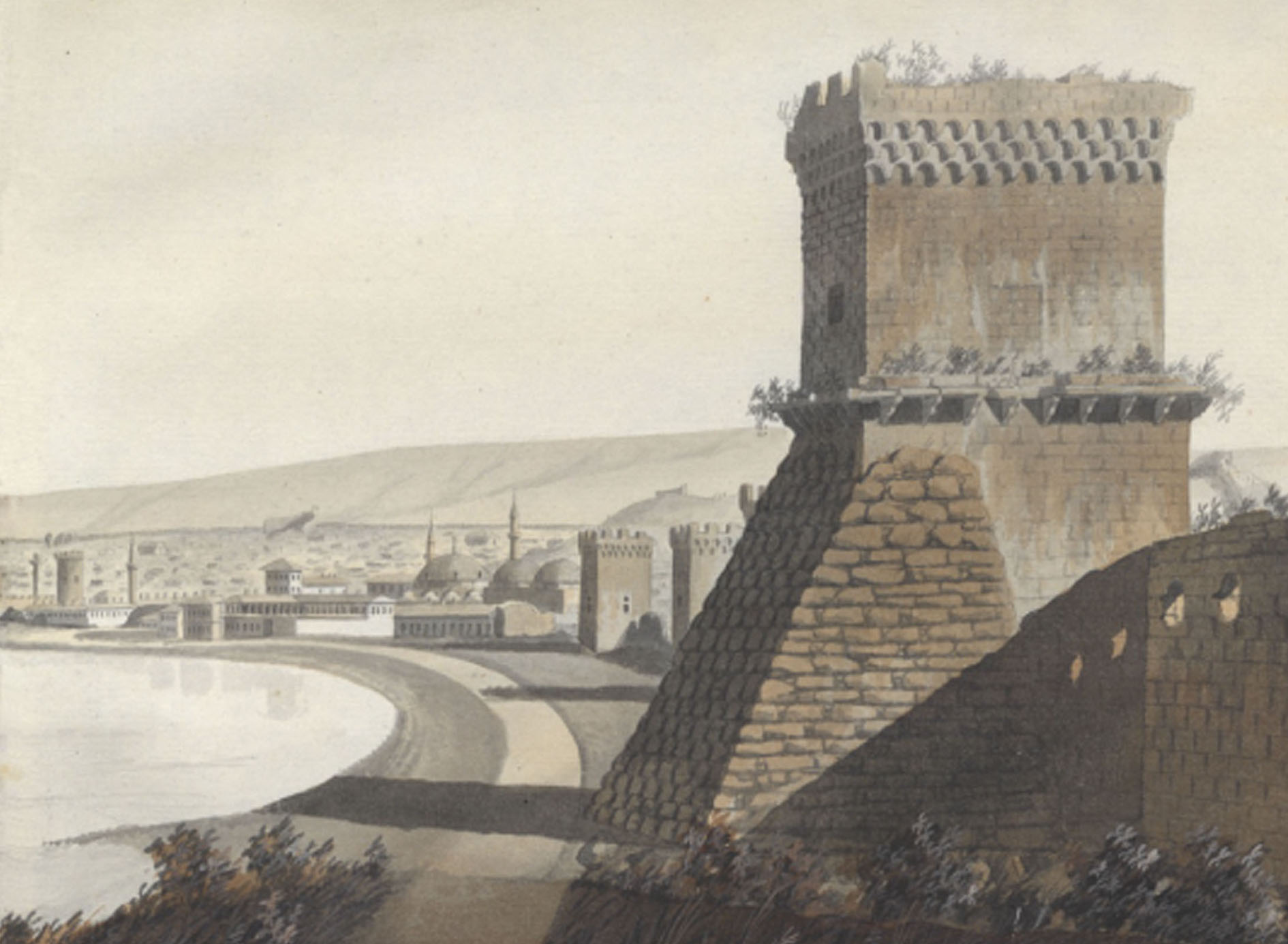Sections of Biyuk Jami in Kefe
DOI:
https://doi.org/10.24852/2587-6112.2023.5.196.210Keywords:
Crimea, Feodosia, Mimar Sinan, shahzade Suleiman-khan, Sultan Selim II, mosque, Ottoman architecture, iconographic sources, drawings by William Hastie.Abstract
Iconographic materials and written evidence are the main source for studying the architectonics of the building of the XVI century, lost in 1833–1834. Their substantive consideration allows us to remove some delusions that are common in scientific circulation and to get important conclusions: supporting arches were not used in the construction of the main dome; the courtyard of the mosque had a roof; images of minarets in the drawing by Ch. G. Geisler, belonging to two different buildings, are combined – Mufti Jami (left) and Biyuk Jami (right). It was also established that the hammam first appeared on the market square, after it the construction of the mosque was started. This is indicated by the broken configuration of the side wall of the Biyuk Jami outer haram from the side of the bath-house, which was formed as a result of the forced fitting of buildings. The doming of the central part of the mosque prayer hall had an original volumetric composition and a well thought-out design, which could well have belonged to the hand of the capital's master, who supervised the construction work at the Crimean structures of Mimar Sinan.
References
Bocharov, S. G. 2016. In Povolzhskaya arkheologiya (Volga River Region Archaeology) 16 (2), 120–137 (in Russian).
Grigor’ev, A. P. 1974. In Efimov, G. V. (ed.). Istoriografiia i istochnikovedenie istorii stran Azii i Afriki (Historiography and Historical Sources for Asia and Africa Countries) 3. Leningrad: Leningrad State University, 19–28 (in Russian).
Dzhanov, A. V. 2019. In Sugdeys'kiy zbіrnik (Sougdeia Collection of Papers ) 2 (VIII), 79–373 (in Russian).
Dzhanov, A. V. 2021. In Sugdeys'kiy zbіrnik (Sougdeia Collection of Papers) 3–4 (VIIII), 163–462 (in Russian).
Dubois de Monpéreux F. 2009. Puteshestvie po Kavkazu, k cherkesam i abkhazam, v Gruziyu, Armeniyu i v Krym. V 6 tomakh. Parizh, 1843. (Voyage autour du Caucase, chez les Tscherkesses et les Abkhases, en Colchide, en Géorgie, en Arménie et en Crimée). In 6 vol. Paris, 1843) 5, 6. Translation, preface and notes by T.M. Fadeeva. Simferopol: “Biznes-Inform” Publ. (in Russian).
Zasypkin, B. N. 1927. In Krym (Crimea) 4 (2), 113–168 (in Russian).
Zilivinskaya, E. D. 2021a. In Zaitsev, I. V. (ed.). Istoriya krymskikh tatar. V 5 tomakh T. III: Krymskoe khanstvo XV–XVIII vv. (History of the Crimean Tatars in 5 volumes. Vol. III: Crimean Khanate XV–XVIII centuries). Kazan: Institute of History named after Sh. Mardzhani, Tatarstan Academy of Sciences, 692–742 (in Russian).
Zilivinskaya, E. D. 2021b. In Materialy po arkheologii, istorii i etnografii Tavrii (Materials in Archaeology, History and Ethnography of Tauria) 26, 343–361 (in Russian).
Kirilko, V. P. 2018. In Kazaryan, A. Yu. (ed.). Voprosy vseobshhej istorii arhitektury (Questions of the history of world architecture) 10. Moscow; Saint-Petersburg: “Nestor-Istoriia” Publ., 222–241 (in Russian).
Kirilko, V. P. 2019. In Bocharov, S. G., Sitdikov, A. G. (eds.). Genuezskaia Gazariia i Zolotaia Orda (The Genoese Gazaria and the Golden Horde) 2. Kazan, Kishinev: “Stratum Plus” Publ., 691–739 (in Russian).
Kirilko, V. P. 2019. In Bazarov, B. V., Kradin, N. N. (eds.). Kochevye imperii Evrazii v svete arkheologicheskikh i mezhdistsiplinarnykh issledovaniy. V 2 kn. Kn. 1 (Nomadic Empires of Eurasia in Archaeological and Interdisciplinary Studies). In two wolumes. Vol. 1. Ulan-Ude: Buryatia Scientific Science Center SB RAS Publ., 119–125 (in Russian).
Kirilko, V. P. 2021. In Povolzhskaya arkheologiya (Volga River Region Archaeology) 36 (2), 93–120 DOI: http://doi.org/10.24852/pa2021.2.36.107.120 (in Russian).
Evliya Çelebi. 1999. Kniga puteshestviia. Turetskii avtor Evliia Chelebi o Kryme (1666—1667 gg.) (The Book of Travels. Turkish Writer Evliya Çelebi on Crimea (1666—1667)). Simferopol: “Tavriia” Publ. (in Russian).
Kononenko, E. I. 2022. Evolyutsiya arkhitektury osmanskoy mecheti (The evolution of the architecture of the Ottoman mosque). Moscow: “Progress-Traditsiya” Publ. (in Russian).
Kutaisov, V.A., Kutaisova, M.V. 2007. Evpatoriya: Drevniy mir. Srednie veka. Novoe vremya (Evpatoria: The Ancient World. The Middle Ages. The Modern History). Kiev: “Stilos” Publ. (in Russian).
de Miranda, F. 2001. Puteshestvie po Rossiyskoy Imperii (A travel through the Russian Empire). Moscow: “Nauka/Interperiodika” Publ. (in Russian).
Iurgevich, V. N. 1889. In: Zapiski Odesskogo obshchestva istorii drevnostei (Notes of the Odessa Society of History of Antiquities) 16. Odessa, 21–45 (in Russian).
In Zapiski Odesskogo obshchestva istorii drevnostei (Notes of the Odessa Society of History of Antiquities) 8. Odessa, 363–403 (in Russian).
Pallas, P. S. 1999. Nabliudeniia, sdelannye vo vremia puteshestviia po iuzhnym namestnichestvam Russkogo gosudarstva v 1793–1794 gg. (Observations made during a Journey across the Southern Governorates of the Russian State in 1793–1794). Moscow: “Nauka” Publ. (in Russian).
Sumarokov, P. 1800. Puteshestvie po vsemu Krymu i Bessarabii v 1799 godu, Pavlom Sumarokovym. S istoricheskim i topograficheskim opisaniem vsekh tekh mest (Travelling throughout the Crimea and Bessarabia in 1799 by Pavel Sumarokov. With a historical and topographical description of all those places). Moscow: University Printing (in Russian).
Tunkina, I. V. 2011. Otkrynie Feodosii. Stranitsy arkheologicheskogo izucheniia Yugo-Vostochnogo Kryma i nachal’nue etapy istorii Feodosiiskogo muzeia drevnostei 1771–1871 (Discovery of Feodosia. Pages of the archaeological study of the South-Eastern Crimea and the initial historical stages of the Feodosia Museum of Antiquities. 1771–1871). Kiev: “Bolero” Publ. (in Russian).
Khrapunov, N. I. 2017. In Problemy istorii, filologii, kul’tury (Journal of Historical, Philological and Cultural Studies) (4), 270–291 (in Russian).
Khrapunov, N. I. 2020. In Bosporskie issledovaniia (Bosporan Studies) 40, 229–238 (in Russian).
Aslanapa, O. 1992. Mimar Sinan. Ankara: Kültür Bakanlığı (in Turkish).
Düzenli, H. İ. 2015. In Coşkun Y. (ed.). Antik Çağ’dan XXI. Yüzyıla Büyük İstanbul Tarihi 8, 176–243 (in Turkish).
Goodwin, G. 1992. A history of Ottoman architecture. London: Thames and Hudson.
Goodwin, G. 1993. Sinan: Ottoman Architecture аnd Its Values Today. London: Saqi Books.
Necipoglu, G. 2005. The Age of Sinan: Architectural Culture in the Ottoman Empire (1539–1588). Princeton NJ.: Princeton University Press.
Rabb, P. 2013. In Periodica Polytechnica. Architecture 44(1), 17–37. DOI: http://www.pp.bme.hu/ar/article/view/7444

Downloads
Published
How to Cite
Issue
Section
License
Copyright (c) 2023 V.P. Kirilko

This work is licensed under a Creative Commons Attribution-NonCommercial 4.0 International License.







